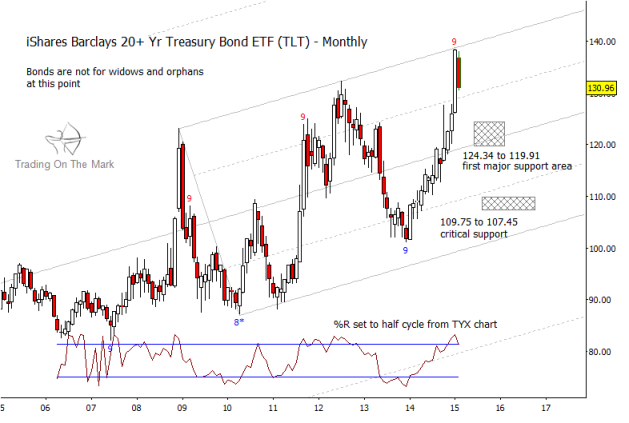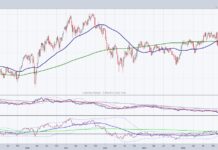January’s low in treasury yields and the consequent high in the price of treasurys has been generating a lot of speculation among traders and analysts regarding whether the two trends can continue. At a time like this, with negative interest rates turning up in parts of Europe, it is a reasonable question. However, we believe it is no longer a safe bet that bond prices will continue to climb. The two leading scenarios in our technical forecast indicate that bonds are near a long-term price high – an idea that also is consistent with our economic outlook. Active traders may still find profitable moves in both directions, but it is time for position investors to reevaluate the risk of treasury bonds.
Our main technical scenario has 30-year Bond Futures tracing the final parts of a large-scale terminal pattern. The chart below shows what has been our primary Elliott wave count since 2010. Price is moving through a nicely defined channel in what appear to be waves consisting of three segments each. If treasury bonds really are completing an ending diagonal pattern, as we believe, then price might see one more decline and rally before it reaches the final high.
30 Year Bond Futures Monthly CHART
Our alternate Elliott wave count also features an ending diagonal pattern, but one that might already be complete (or nearly so). If the alternate count is operating, with a truncated high occurring late in 2014, then we would expect the next price swing to show signs of breaking downward out of the channel rather than finding support in the 136-140 area that is featured on our main chart. You can view a chart with the alternate count in a companion article on our website, Trading On The Mark.
The dominant 41-month price cycle lines up with both our main and our alternate forecast, suggesting that bond prices may find a high or a lower high near the beginning of 2016, while interest rates bounce concurrently from a real low. It is important to note that neither of our scenarios calls for bond prices to crash after 2015 or for interest rates to rise outlandishly, but we expect the trend to change.
A chart of one of the main ETFs that tracks 20-year bond prices emphasizes the likelihood that bonds generally are reaching a meaningful high, even if it is not necessarily the final high. The share price for the iShares 20+ Year Treasury Bond ETF (TLT) recently tested the top of a channel that has fit well with price extremes since 2010. Note also the important exhaustion signal that the Wave59 “nine-five” indicator placed on the January candle – something that correlates frequently with a change in direction.
iShares Barclays 20+ Year Treasury Bonds (TLT) Monthly CHART
If TLT finds support at one of the two areas we have marked on the chart (119.91-124.34 and 107.45-109.75), then the first assumption will be that price has completed a retrace and may attempt a sizeable rally. However, if those support areas fail, then we should start to see a scenario matching our alternate one for 30-year bonds.
As economic context, it is clear that central banks cannot continue buying treasury issues indefinitely. The run of quantitative easing and similar strategies in the U.S., Europe and Japan has enabled governments to add a nearly unimaginable amount of debt to the global economy, while simultaneously creating a situation where much of that debt is unlikely to be repaid. We believe bond markets will begin realizing that constraint soon, if they have not already noticed it, and treasury bonds should start reflecting diminished expectations for complete repayment. This will become part of the larger process of adjustment which we have mentioned in other pieces here, including the recent article about copper prices.
At TOTM, we are dedicated to showing how traders can make profits consistently even in challenging market conditions. Follow us on Twitter to get timely notices and updates.
Follow Tom & Kurt on Twitter: @TradingOnMark
No position in any of the mentioned securities at the time of publication. Any opinions expressed herein are solely those of the author, and do not in any way represent the views or opinions of any other person or entity.










